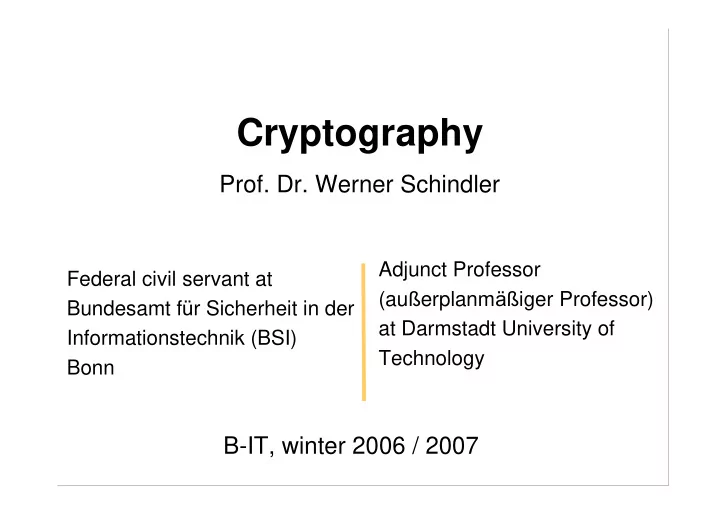

Cryptography Prof. Dr. Werner Schindler Adjunct Professor Federal civil servant at (au ß erplanm äß iger Professor) Bundesamt f ü r Sicherheit in der at Darmstadt University of Informationstechnik (BSI) Technology Bonn B-IT, winter 2006 / 2007
2 Structure of the Course Chapter A: Introduction Chapter B: Symmetric Ciphers Chapter C: Public Key Cryptography
3 A) Introduction
4 A.1 Development of Cryptography • The history of cryptography dates back more than 2000 years ago. • Already Julius Cesar encrypted important messages (Sueton, Roman historian).
5 A.2 Julius Cesar ‘ s Cipher (I) JDOOLD HVW RPQLV GLYLVD ... plaintext alphabet: ABCDEF G HIJKLMNOPQRSTUVWXYZ ciphertext alphabet: DEFGHI J KLMNOPQRSTUVWXYZABC GALLIA EST OMNIS DIVISA ... [Translation: Gallia (today ’ s France) is divided into three parts ...]
6 A.2 Julius Cesar ‘ s Cipher (II) • Cesar ‘ s cipher defines an encryption scheme in a modern sense (though a very weak one). • It applies an algorithm to transfer plaintext into ciphertext, using a key • Algorithm: w rotate the plaintext alphabet by k (= key) positions to the left ( = ciphertext alphabet) w substitute the plaintext letter by the corresponding ciphertext letter • Cesar used the key k = 3
7 A.1 (continued) Development of Cryptography (II) • It is very easy to break Cesar ‘ s cipher: An attacker just has to decrypt a given ciphertext with all 26 admissible keys. Only one key (the correct key) yields meaningful plaintext. • Cryptographic algorithms have been attacked, broken and improved for the last 2000 years. • Before the eighties cryptography was mainly applied by the military and intelligence services.
8 A.3 Cryptography in everyday ‘ s life • By the spreading of smart cards and the internet cryptography has found its way into our daily life although we are often not aware of this fact. • Examples: w Bank cards and credit cards at automated teller machines w Home banking, e-commerce w Credit card transactions over the internet w Mobile communication w Electronic purses (smart cards) w …
9 A.4 Example a) Automated teller machines (ATMs) processing centre ATM card, PIN card data, PIN authorization if Cash (if all requirements authorized by are fulfilled the process- PIN check, ing centre) limit check, credit rating etc. Remark: The ATM encrypts the entered PIN before transmission.
10 A.4 b) Credit card payment over the internet acquirer . . . payment info authorization order, payment info (card number, amount ...) delivery of goods customer merchant
11 A.4 c) Electronic purse system clearing centre merchant ‘ s customer ‘ s bank book money bank book money b o (6) (5) o k (7) m o n e 15 € y (2) submission of merchant ‘ s Load: (1) collected units 15 units account (4) 5 units (3) goods terminal customer merchant
12 A.4 d) GSM mobile phone HLR, VLR, ... (registers) router router Conventional telephone network or other mobile base station base station network air interface mobile phone
13 A.5 Important Security Requirements Requirement / Bank cards / Credit card Electronic Home Mobile desired credit cards payment over purse banking communication property at ATMs the internet systems to be kept PIN credit card PIN / PIN, transmitted secret number TAN data data integrity account price, delivery records amount, yes number, address destina- amount tion card holder – merchant – purse – user – SIM authentication account processing card holder, terminal, holder - card, SIM card - merchant – centre, ATM terminal - bank network – processing acquirer, … purse, … centre, … non-repudiation yes yes no yes yes long-term transaction transaction system- trans- no storage of data protocols protocols dependent action records
14 A.6 Remark • Security requirements as secrecy, data integrity and authenticity, for instance, can be assured by cryptographic algorithms and protocols. • This will be the focus of this course. As far as possible these mechanisms will be motivated and illustrated by applications. • We point out that even strong cryptographic mechanisms may be overwhelmed if there are flaws in their implementation (Keywords: hardware attacks, side-channel attacks, fault attacks, cache-based attacks, bugs in the network protocol, vulnerability to viruses, worms and trojan horses, weaknesses of the operating system, … ). • In this course we will not consider these topics.
15 A.7 Some Further Historical Notes • Maria Stuart (1542-1587, Queen of Scotland) was sentenced to death because of weakly enciphered letters. • In the Renaissance cryptography belonged to the esoteric arts. • Cryptography in literature: In “ The Gold Bug ” (E.A. Poe), for instance, a solved cryptogram reveals the location of a treasure. • During the second world war the allies broke the German Enigma, a mechanical enciphering machine. This was maybe the greatest cryptanalytic success in the 20 th century.
Recommend
More recommend